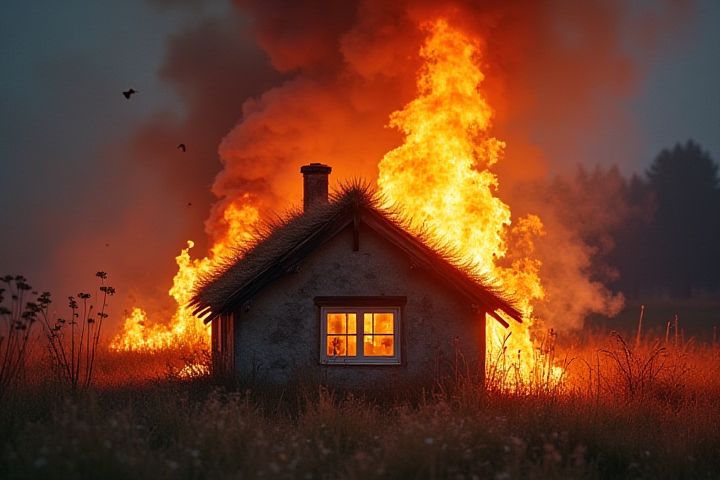
A house can be designed to be fire-resistant through various architectural and material choices. Utilizing fire-rated materials such as brick, stucco, or concrete for exterior walls can significantly enhance a building's ability to withstand flames. Installing tempered glass windows and using metal roofs also contribute to resistance against high temperatures and sparks. Landscaping plays a critical role as well; incorporating defensible space around your property helps to reduce wildfire risk by maintaining a buffer of non-flammable vegetation. Regular maintenance and adherence to local fire safety codes further ensure your home remains protected from fire hazards.
Can A House Be Fire Resistant
Fire-resistant materials
Fire-resistant materials, such as concrete, brick, and steel, significantly improve a house's ability to withstand flames and extreme heat. The use of Class A fire-rated roofing materials, like asphalt shingles or metal tiles, can reduce the risk of ignition from external fire sources by up to 95%. Incorporating fire-resistant siding, such as fiber cement or stucco, can enhance your home's protection, offering ratings of up to 1 hour against direct flame exposure. When selecting windows, consider tempered glass or dual-paned designs, which can resist temperatures exceeding 1,000 degrees Fahrenheit, further safeguarding your property.
Building codes
A house can be made fire-resistant by adhering to specific building codes that dictate materials and construction methods. These codes often require the use of non-combustible materials for roofs, walls, and siding, such as metal or stucco, to enhance fire safety. Fire-resistant windows with tempered glazing and fire-rated doors also play a crucial role in minimizing the spread of fire. Ensuring proper landscaping and maintaining defensible space around your home can further reduce fire risk while adhering to local fire safety regulations.
Fire-rated doors
Fire-rated doors can significantly enhance your home's fire resistance by providing up to 90 minutes of protection against flames and smoke. Constructed from materials like steel or gypsum, these doors are designed to contain fire to a specific area, potentially limiting property damage and saving lives. Installing a fire-rated door enhances safety, especially in critical areas like the garage or between living spaces and utility rooms. Regular maintenance, including checking the door's seals and hardware, ensures optimal performance in case of an emergency.
Fire-resistant roofing
Fire-resistant roofing can significantly enhance your home's ability to withstand flames, making it a critical feature for fire safety. Materials such as asphalt shingles, metal, and clay tiles offer superior resistance to fire compared to traditional wood shingles, which have a high combustion risk. Installing fire-rated roofing not only protects your property but can also potentially lower your homeowner's insurance premiums by minimizing fire hazards. According to the National Fire Protection Association (NFPA), homes with fire-resistant roofs are 20-80% less likely to sustain damage from wildfires, underscoring the importance of this investment for your peace of mind.
Non-combustible siding
Non-combustible siding is an excellent choice for enhancing the fire resistance of your house. Materials such as fiber-cement, stucco, and metal siding provide a crucial barrier against flames, significantly reducing the risk of fire damage. When selecting non-combustible siding, consider its ability to withstand extreme temperatures and its durability against the elements. Investing in such materials not only protects your home but also may reduce insurance premiums and increase property value.
Fire-resistant windows
Fire-resistant windows significantly enhance a house's overall fire resistance, with materials like tempered glass or heat-strengthened glass being crucial. These windows can endure temperatures up to 1,000 degrees Fahrenheit, preventing flames and heat from penetrating your home. Choosing windows with multi-layered construction can further improve safety, as they provide additional barriers against fire. Installing fire-resistant windows may reduce the risk of property damage and enhance safety for occupants, making them an essential consideration in fire-prone areas.
Sprinkler systems
Incorporating a sprinkler system significantly enhances a house's fire resistance by providing an automatic means to extinguish fires during their initial stages. These systems utilize strategically placed water sprayers that activate when detecting heat, effectively reducing fire spread and minimizing damage. Regular maintenance and inspection of your sprinkler system, including checking for proper water pressure and ensuring no obstructions, are crucial for optimal performance. By investing in modern, state-of-the-art sprinkler technology, homeowners can significantly improve their fire safety measures and provide peace of mind.
Fire barriers
Fire barriers are crucial elements in enhancing a house's fire resistance, designed to slow the spread of flames and heat. Typically made from non-combustible materials, such as concrete, gypsum, or brick, these barriers can compartmentalize the structure, effectively safeguarding different areas. Building codes often require specific fire ratings for barriers, which can range from one hour to multiple hours, depending on the building's use and occupancy. Implementing fire barriers strategically can significantly improve your home's safety and increase its resilience against destructive fire incidents.
Ember-resistant design
Ember-resistant design significantly enhances a house's fire resistance, particularly in wildfire-prone areas. Utilizing non-combustible materials such as stucco, brick, or metal for siding can prevent ignition from airborne embers, which travel at speeds of up to 20 miles per hour. Furthermore, installing dual-pane tempered windows reduces the risk of breakage, while enclosed eaves and metal mesh vents prevent ember entry into attics or crawl spaces. By integrating these features, your home can better withstand extreme heat and flying debris, improving overall safety during fire events.
Landscaping considerations
Incorporating fire-resistant landscaping is essential for enhancing your home's fire safety. Utilize native plants that are drought-resistant, such as lavender or sage, which typically have higher moisture content and are less flammable. Maintain a defensible space of at least 30 feet around your house by removing dry leaves, debris, and flammable mulch, replacing it with gravel or rock to reduce fire risk. Installing hardscapes like stone pathways and non-combustible fences further protects your property from potential wildfires.
